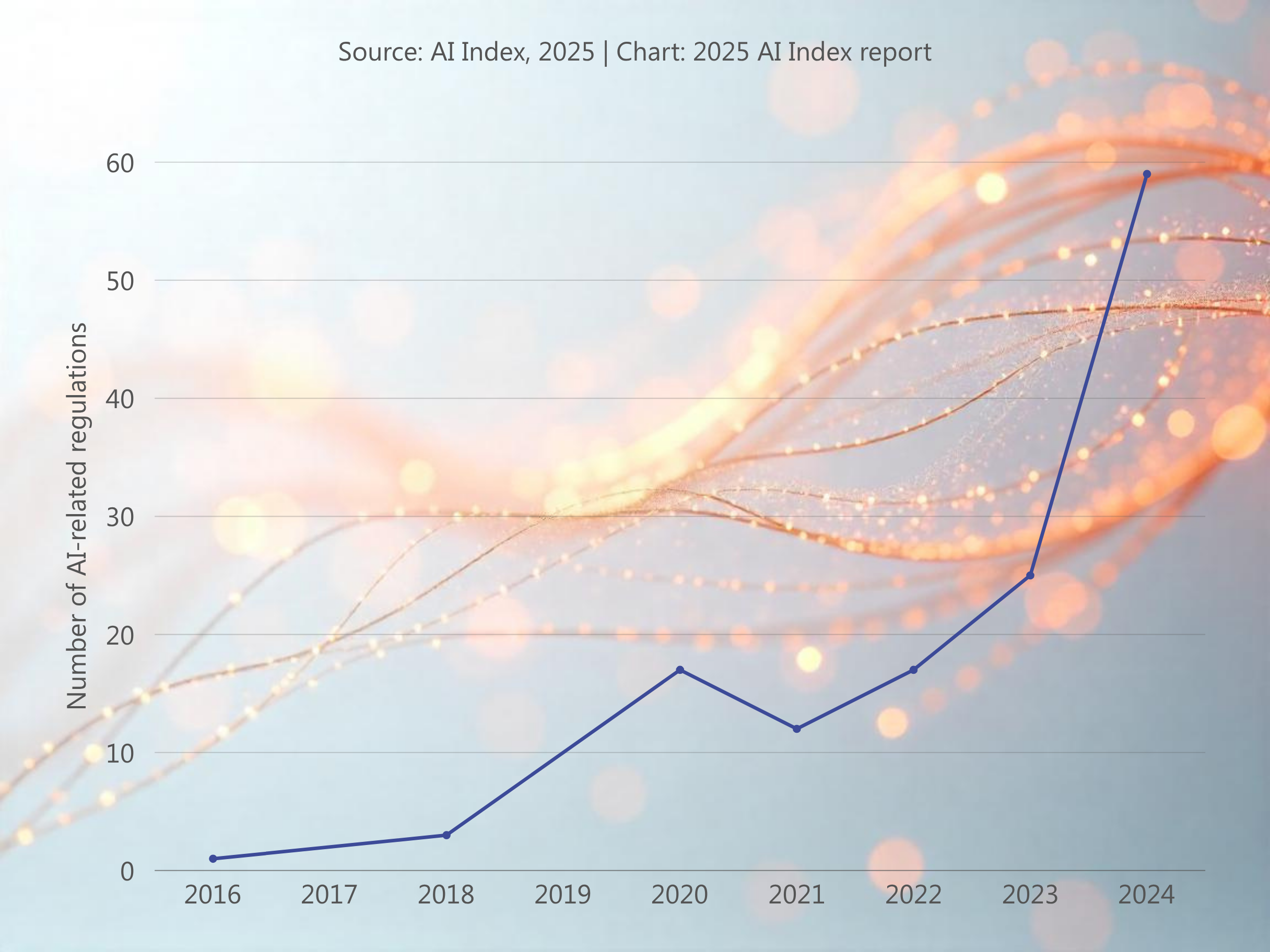AI’s impact on the telco sector is growing
Artificial intelligence in telecommunications mainly focuses on strategic implementation of its technologies in streamlining operations. Examples of these operations include automating routine tasks, using AI’s predictive capabilities to anticipate network failures, analyzing user data and preferences, and even content delivery and video analytics.
The latest reports from Nvidia indicate that 84% of global telecommunication companies reported revenue growth with AI adoption. 21% of telcos report that AI has helped boost their revenue by 10%, while others report reduced losses since implementing AI. These statistics illustrate the impact of artificial intelligence on the telecommunications sector.
The impact ranges from network optimization and customer service to fraud detection, cybersecurity, market analysis, regulatory compliance, and even data monetization. Nevertheless, the widespread impact has led to ethical considerations. In the US, the number of AI regulations increased significantly between 2023 and 2024, reflecting the government’s push for ethical oversight of the sector.

Source: Stanford University 2025 AI Index Report
1. Optimizing Telecommunication Network with AI
For network optimization, AI systems or algorithms can analyze network data to identify congestion points, predict traffic patterns, and allocate network resources efficiently. As such, telecommunications systems can effortlessly handle increased loads without sacrificing performance.
With AI, telcos can automate critical tasks, including fault detection, traffic routing, and capacity planning. This automation is especially true for 5G systems, where AI is integrated to adjust configurations and improve energy efficiency autonomously.
Case Study: Samsung & SK Telecom: AI-Driven 5G Network Optimization
In 2024, Samsung Electronics and SK Telecom initiated a commercial deployment of the AI-RAN Parameter Recommender, a deep learning–based system designed to optimize 5G Radio Access Network (RAN) performance. The AI model, trained on SK Telecom’s extensive network data, evaluates key metrics such as signal-to-interference-plus-noise ratio (SINR), traffic congestion, mobility patterns, and radio frequency conditions to generate real-time, site-specific configuration recommendations.
The AI recommender fine-tunes over 40 base station parameters, including beamforming settings, transmission power, antenna tilt, and handover thresholds. In trial deployments, this resulted in a 24% increase in downlink throughput, a 15–20% reduction in latency, and notable energy savings through adaptive resource allocation. These enhancements were achieved without hardware upgrades, relying solely on software-driven intelligence.

The system supports multi-objective optimization, enabling telcos to balance priorities such as performance, energy efficiency, and user experience. It also integrates with O-RAN-compliant RAN Intelligent Controllers (RICs) for distributed AI decision-making across vendor-neutral infrastructure.
This partnership marks a clear shift toward AI-native telecom networks, where automated, intelligent RAN management enables more agile, scalable, and cost-efficient service delivery.
For more details, refer to: https://www.rcrwireless.com/20241028/network-infrastructure/sk-telecom-samsung-use-ai-optimize-5g-base-stations
2. Enhanced Fraud Detection and Cybersecurity
When it comes to fraud in the telecommunications sector, we have international revenue fraud, one-ring scams, SIM swapping, subscription fraud, and PBX hacking. These present several complex challenges for telecommunication companies. However, these challenges are being addressed with the implementation of AI.
Telecommunication companies now integrate machine learning predictive analysis, real-time fraud monitoring, natural language processing, and even enhanced customer profiling for fraud detection and prevention.
AT&T is one of the major telecommunications companies integrating AI to combat fraud. The company monitors traffic with AI-driven analytics and integrates AI systems to identify unusual call patterns and sudden spikes in international calls.
Vodafone is another telco that has successfully integrated AI systems to identify and block spam numbers and messages.
3. Quick and Thorough Market Analysis
With AI and machine learning systems, telcos can quickly make sense of a vast amount of user data generated daily. A recent global digital overview indicates that over 5 billion people were using the internet at the start of April 2025. With the average user spending 33 hours online daily, Dell Technologies estimates that there will be approximately 79.4 zetabytes of data in 2025.
AI systems are not just quick but also thorough when it comes to market analysis. Telecommunication companies now use them to identify customer behavior and make personalized recommendations, predict customer churn, identify customer segments with the highest conversion potential, and even segment customers based on demographic, usage patterns, and age brackets. Customer data platforms (CDPs) are integral in these analyses, as they unify data from different sources and share it across AI-powered systems.
Verizon’s AI implementation in market analysis is one of the most prominent case studies. The company uses AI to identify customers who travel frequently. This data allows Verizon to offer such customers personalized roaming plans beforehand. We also have real-time customer segmentation, which is the backbone of Verizon’s marketing strategies.
4. AI in Customer Support
Telcos such as Verizon and AT&T have adopted chatbot systems to improve customer support. These bots can handle routing customer inquiries and even offer self-service options. They also provide 24/7 support, freeing up human agents for more complex support tasks.

Current reports indicate a 25% increase in customer satisfaction since the introduction of chatbots. AI chatbots can make real-time recommendations to customers based on their behavior. Some provide proactive services, like Verizon’s AI systems. These can analyze customer data and predict potential issues, such as network disruptions or billing concerns.
What’s even better is that these chatbots or virtual assistants use natural language processing for their interactions. As such, you can communicate with them just as you would with an actual human agent. These AI-driven support systems not only understand complex queries but can also retain context in conversations.
Another example is Vodafone’s TOBI. This chatbot can facilitate plan upgrades, resolve queries, and process transactions. Vodafone has reported a 47% reduction in checkout times since integrating TOBI into its operations. The conversion rates and overall customer satisfaction are also better.
Improvements in customer experience metrics driven by the introduction of AI and the derived financial gains, can be further optimized when using digital-human models. The hybrid models integrate automated digital tools with human support systems, designed to deliver efficiency and empathy. While digital tools enable scalability and process optimization, human intervention remains accessible to address complex or sensitive interactions, ensuring a seamless and empathetic customer experience.
5. AI in Regulatory Compliance
With AI algorithms, telcos can easily monitor policy changes from various sources, both local and international. These sources include government websites, industry publications, and legal databases. AI systems can automate tasks, respond to anomalies immediately, and minimize compliance risks. These systems generally employ machine learning, natural language processing, and predictive analysis.

Deloitte’s findings reveal that 67% of companies have adopted or increased their investments in generative AI, a major player in AI-driven regulatory compliance monitoring. These AI-driven systems can monitor transactions, verify customer due diligence checks, screen customers against sanctions lists, automate reports and audits, and provide real-time updates on regulatory changes.
Today, companies can either develop in-house AI tools or adopt comprehensive GenAI platforms to ensure regulatory compliance. These platforms offer various tools, from customer verification during onboarding to anti-money laundering measures, transaction screening, and ongoing KYC.
6. AI in 5G Deployment
The recent Ericsson Mobility Report predicts that 85% of the global population will have access to 5G coverage by 2030. While a welcome development, these statistics pose challenges for managing the traffic. Intelligent network slicing is one of the AI-driven solutions to this traffic optimization and management. It was one of the highlights for Telenor at the 2025 Mobile World Congress. Telenor collaborated closely with Nvidia and BubbleRAN in developing this innovative technology, which leverages artificial intelligence and machine learning to manage and optimize network slices, not only in 5G but also for future networks.
Telecommunication networks will be capable of real-time self-adjustments with the aid of AI. They will be capable of adjusting their bandwidths and processing power. As such, failures like buffering during streaming, dropped calls, and slow internet speeds will be significantly reduced or even eliminated.

The 5G network opens doors to possibilities such as smart cities, immersive VR and AR, and industrial IoT. Current developments in this regard include the partnership between Nokia and KDDI. The strategic partnership aims to explore how to leverage GPUs and generative AI to reduce 5G network-related costs, enhance network quality, and lower power consumption.
Several other companies, like Siemens, Singtel, and Ericsson, are exploring various AI-powered solutions to optimize 5G networks during deployment.
Ethical Challenges
The ethical concerns regarding the use of AI in the telecom industry encompass bias in training data, data privacy, accountability, transparency, explainability, and security. For these reasons, governments around the world have implemented or are in the process of implementing policies to protect telecom companies and their users. An example is the UK government’s principles on AI adoption, which promote the responsible use of artificial intelligence in the sector.
Telecommunication companies have turned to AI to tackle ethical and compliance issues. These AI-driven solutions include explainable models that create inclusive datasets to minimize bias and enhance the transparency of AI processes.
Conclusion: Harnessing AI for the Future of Telecommunications: Salience’s Vision and Commitment
At Salience Consulting, we recognize that artificial intelligence is not just transforming the telecommunications sector; it is redefining the very core of how digital infrastructure is designed, managed, and scaled. As a leading consultancy in digital transformation and telecom strategies across Africa, the Middle East and beyond, Salience Consulting is actively exploring how AI can be strategically integrated into our service offerings to help clients unlock new efficiencies, smarter operations, and scalable growth.
From network optimization and fraud detection to 5G deployment, customer experience, and compliance, the transformative use cases of AI closely align with our mission to deliver agile, data-driven solutions. We are currently building internal capabilities and partnerships to assess how AI-driven approaches, such as predictive analytics, intelligent automation, and generative tools, can be effectively embedded into future project delivery and advisory methodologies.
Whether advising regulators on telecom policies, designing national broadband strategies, or supporting operators with digital maturity assessments and rollout plans, we see AI not as a standalone technology but as a fundamental capability. Through strategic foresight, knowledge development, and innovation-driven engagements, Salience Consulting positions itself to help governments and telecom operators use AI responsibly as they prepare for the challenges of a hyperconnected, intelligent future.
Salience embraces key future trends in digital transformation, and the human role in a tech-driven future, by recommending hybrid digital-human models, to maximize customer satisfaction and the associated financial gains.
In this rapidly shifting landscape, Salience Consulting remains committed to being more than just a technology advisor; we are your transformation partner, helping shape resilient, intelligent, and inclusive telecom ecosystems powered by AI.
Author
Ammar Hamadien
Principal Consultant
and Head of Strategic Partnerships

